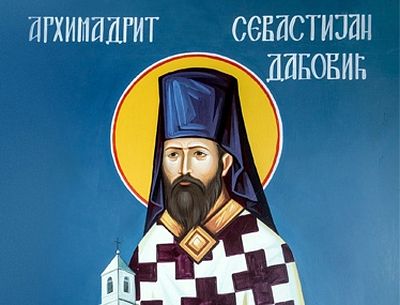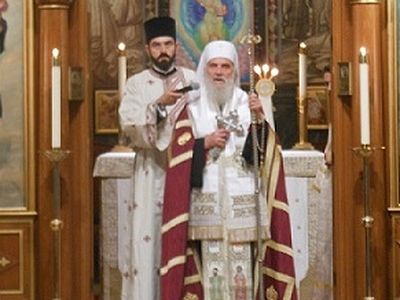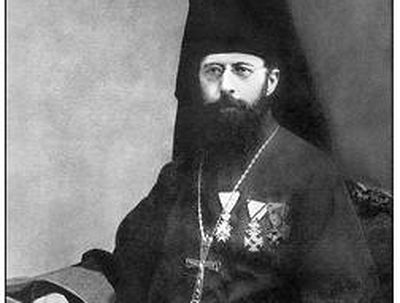Alhambra, CA, September 8, 2015
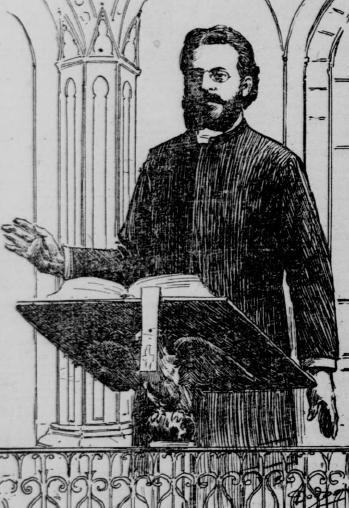
The festivities of the Nineteenth Diocesan Days gathering of the Western American Diocese of the Serbian Orthodox Church in North and South America continued on Saturday following the Divine Liturgy in which the proclamation of glorification of St. Sebastian Dabovich was read with a symposium luncheon. The symposium was emceed by Fr. Josiah Trenham, pastor of St. Andrew Orthodox Church (Antiochian) in Riverside, CA and featured several instructive and interesting discussions concerning the life, canonization and icons of St. Sebastian from various special guests.
From the words of the various speakers it is clear that St. Sebastian was a holy man, greatly loved by those who knew him and those who have come to know him after his repose.
* * *
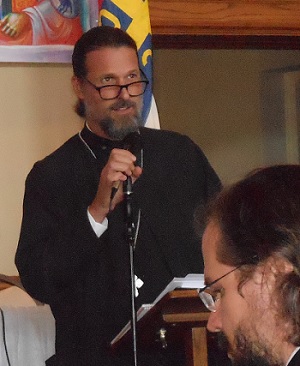 Fr. Josiah Trenham emceeing the St. Sebastian symposium
Fr. Josiah Trenham emceeing the St. Sebastian symposium Brothers and sisters this is a very delightful day and a day of tremendous significance for us Orthodox Christians to celebrate the day of glorification of St. Sebastian of San Francisco. The glorification of a saint is an honor and ennobling of human nature. It is the unveiling of the true calling of every one of us in this room and of every human being. It is the accomplishment of God’s will for the human race and it is the culmination of all of the saving acts of our Lord Jesus Christ. It is the reason for the Incarnation, it is the reason for the Transfiguration, it is the reason for the Passion and Crucifixion of our Savior. It’s the fruit of the Resurrection. It is the continuance of our Savior’s ennobling of human nature through the glorious Ascension forty days after His Resurrection and it is the direct result of the outpouring of the Holy Spirit on the Church on the day of Pentecost. St. Sebastian therefore holds for all of us tremendous significance and his elevation into Heaven is not just a magnificent delight for God Who wills this for us all but also for us. Holiness is possible.
Following his introduction, His Eminence Abp. Demetrios was invited to offer some prefatory remarks in which he spoke about the phenomenon of persecution against the Orthodox Church:
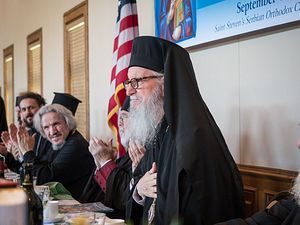 His Eminence Archbishop Demetrios
His Eminence Archbishop Demetrios I would like to speak first a little bit about Patriarch Irinej. Why? Because Patriarch Irinej is not just one of the nine patriarchs existing today in our Church—he is the patriarch of a Church that has a history of tremendous ordeals and pains and martyrdom up to our day. It is a heroic Church with a heroic tradition and we are very conscious of that. We grew up with Yugoslavia and we remember the year 1941 when the German Nazi army came through Yugoslavia and we heard about the massacre of plenty of Serbian people. We have plenty of martyrs from that time, and they killed plenty of clergy. Then we had Yugoslavia under a Communist regime for years. And when the time came for a change in the whole east, here comes the disintegration of Yugoslavia. It didn’t happen without pain and without blood. There was plenty of blood …
This is something that is a continuous crucifixion of the Church of Serbia and this is why I’m talking about the Patriarch who is representing this Church, this Patriarchate, and this kind of Orthodox Christians. And this is why we love and respect Patriarch Irinej and the people of Serbia. And we know that we are part in the twentieth and twenty-first centuries of a really unbelievable time of persecution … Thirty million people, mostly Orthodox, have been martyred in the twentieth century. The genocide of the Armenians, the genocide of the Balkans, the genocide in Asia Minor, the genocides in Serbia and other places, the millions of Ukrainians [and Russians] under Stalin—thirty million. And if that was not enough, here comes the twenty-first century and we have the persecution and massacre in the Middle East in an obvious attempt to exterminate Orthodox Christians from the place of birth of Christianity, so that today as we celebrate the canonization of a new saint, the person of St. Sebastian, we do have, with the presence of the Patriarch, and the knowledge of the Church, quite a deal of suffering and carrying the cross of Christ.
Persecution for us is not a new thing. We grew up as a Church with persecution. It started with the Head of our Church, Jesus Christ, the first martyr of the Church, St. Stephen, and the martyrs that followed, and so we are familiar. We are not to succumb to contemporary persecutions, no matter how well organized, no matter how devilishly they are organized, and we are not going to succumb. We are going to resist and we are going to continue as we have been for twenty centuries without any interruption. We welcome you, Your Beatitude and Holiness to our country. We welcome you as representing not only the Church but in national terms the heroic Serbian Orthodox people, and we wish you many happy years in serving this Church and celebrating the canonization of many more in addition to St. Sebastian.
Following His Eminence’s emboldening words Fr. Josiah read the letters of His Beatitude Metropolitan Tikhon (OCA) and Most Rev. Jose Gomez, the Roman Catholic Archbishop of Los Angeles who were not able to attend the day’s events, which was followed by a reading by Jelka Kortinski from the life of St. Sebastian:
St. Nicholai Veilimirovich met with at that time Fr. Sebastian in 1915 in San Francisco. A close spiritual kinship developed between these two dedicated missionaries. St. Nicholai was later to describe Fr. Sebastian: “He was a sincere and convinced believer, and a Christian missionary of world scope. He traveled restlessly and preached and lectured indefatigably. He composed books, wrote articles, epistles and thousands of private letters to laymen and priests with needed explanation and encouragements. He spoke and wrote in Serbian, English, and Russian. His handbag was always full with New Testaments, religious booklets, printed sermons and tracts, and also with small crosses for boys and girls. He never visited a Serbian family empty-handed. He remembered the apostolic words It is more blessed to give than to receive.
And from his own writing on “sincere religion” from 1898:
To read the Bible does not mean to be a Christian. One may go to Church and also study the Holy Scriptures and yet not be religious. One may be religious and yet be laboring under false impressions and untruthful doctrines … Even if you have His words are you sure of God’s opinion? Are you so elevated that you can read God’s mind? “Obey and believe in my doctrine,” says Rome. “Be free and strive to create a belief for yourself” say the sects. But the Church calls to her own. Let us love one another that we may with one mind confess Father, Son and Holy Spirit. Truly glorious and divine is the Church. But beware of judging by the failures and errors of her unworthy children. Let us pray to the Lord for the peace of the whole world, the good estate of the holy Churches of God and the union of them all, for the unity of the faith and the communion of the Holy Spirit. Let us commend ourselves and one another and all our life to Christ our God.
Next Fr. Josiah invited His Grace Bp. Maxim to speak on the process leading to the glorification of St. Sebastian, who truly knew what means sincere religion:
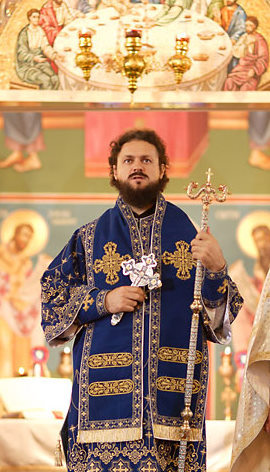 His Grace Bishop Maxim
His Grace Bishop Maxim Of course we can invite professors of hagiology to offer lectures. We can invite even their students who passed their exams with an A to tell us about it, and then we will learn just something, because in the realm of the Church everything is a surprise. In everything, as St. Chrysostom says, there is a procedure and there is non-procedure. God is free to elevate anyone and recognize and demonstrate that holy person. Through St. Sebastian we learn how a little child born in San Fran becomes a holy person and radiates this thunderbolt of ever-living fire to everyone seeking what is promised.
Everything starts from a local community, from those persons who are members of the Church and recognize among themselves those who are examples, and the Church officially recognizes that voice so that the names of these holy persons are included in the diptychs and calendar of the Church and they serve as an example … the Serbian Church which is one of many Orthodox autocephalous Churches has this initiative to announce and make it clear to the entire world and Churches that St. Sebastian is another great addition in the calendar of the saints and now we are free to hymn him, and address him in our prayers: holy venerable Father Sebastian pray unto God for us.
In introducing the next speaker, Fr. Josiah noted that in America we have the calling and responsibility of both ecumenical and evangelistic efforts and that St. Sebastian took up both these responsibilities, especially to the Unia and Episcopalians, without ever watering down the truth of holy Orthodoxy which he held so dear:
The question put before us now is, how can St. Sebastian serve as an exemplar to Orthodox Christians today in their dual responsibilities—ecumenical and evangelistic?
To answer, Fr. Josiah called upon Fr. Damascene (Christensen), abbot of St. Herman’s Monastery in Platina, California, whose brotherhood has been instrumental in bringing the name of St. Sebastian to a wider audience through the publication of various articles about him in their Orthodox Word journal:
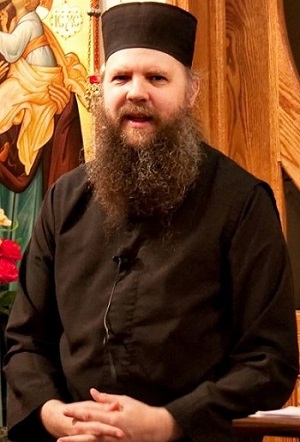 Abbot Damascene (Christensen)
Abbot Damascene (Christensen) Fr. Josiah talked about ecumenical and apostolic activity. I would also say that Fr. Sebastian lived at a time when Orthodox Christianity was coming to America from all different parts of the world and there was some dissension from different Orthodox Churches. There was a lot of nationalism. The Serbs were starting to think that Fr. Sebastian was too Russian and the Russians were thinking he was too Serbian and so they were associating Orthodoxy with nationalism and Fr. Sebastian was very much above that. As I said he wanted Orthodoxy for all peoples. He really stepped back from all of that and stood for Orthodox unity in this country and wanted a united Orthodox witness so that all people from all different backgrounds could be Orthodox and so that we would have one Orthodox Church in America.
Following on Fr. Damascene’s words concerning the problematic nationalism that St. Sebastian faced, Fr. Josiah noted that St. Sebastian lived in multi-ethnic Orthodox milieu, with people coming to California from all over the world as part of the gold rush. He noted that St. Sebastian’s parents arrived in 1853 and although the group of Orthodox believers that they found had no priest they all gathered and sang hymns in one another’s homes on Sundays and the great feasts, regardless of ethnicity. As Fr. Damascene stated, he felt pressure from Serbians and Russians but wanted no division.
To answer the question of how St. Sebastian’s witness can contribute to Orthodox unity in America today, His Grace Bp. John of the Moscow Patriarchal parishes in America next took the mic:
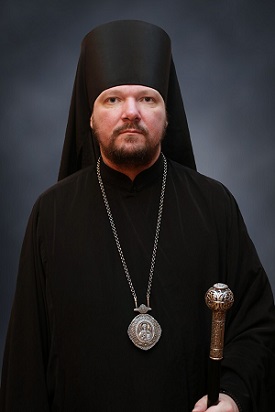 His Grace Bishop John
His Grace Bishop John These two saints got their education in Russia and some of them knew Patriarch Tikhon who in the beginning of twentieth century was here first on the west coast and then he moved the cathedra to New York because most of the people from different ethnic backgrounds were immigrating there to this country. These thoughts were posed also by holy Patriarch Tikhon who lived in the very tragic time of turmoil in the political life in Russia during the revolution when authorities came in power who neglected not only Church, but the notion of God Itself. And the experience that St. Patriarch Tikhon acquired here in the US really helped him to manage the Russian Orthodox Church through the hard times.
He was one of the first men who actually introduced multi-ethnic Church administration here in the US. Hopefully to some extent, at some point we have to trace back those thoughts and look at those historical experiences that Serbian, Russian, Greek, and Syrian people had here back then, so we can learn from them how to live together more closely. During the twentieth century a lot of things happened not only in Europe and Russia where there was persecution among the Christians but here the Church life was also touched by those processes. One of the sorrows to the people, priests, and bishops was a lot of questions about how we can really be one Church all together and serve Christ for the good of us all?
I would like from this moment to pray to these two saints so they will enlighten us in our struggle, in our thoughts, in our way for this unity, to look for the experience they had. Let’s not forget that Church in the United States has a more than two-hundred year history—that’s not only a little. Of course we have Mother Churches in the whole world which trace their history for thousands of years and of course they have the experience of Ecumenical Councils., local councils, interactions with each other and sometimes with problems. And here we have the opportunity to build something that will give us a new sense of unity in the US.
I would like to say that today when we see that in the whole world we still have problems, including in Church relations, here in the US we’re building something that can help to resolve those issues in the whole world, and give us a good opportunity to exercise our faith, belief, and our unity in Christ. Again I would like to thank you, Your Holiness, Your Eminences, your graces, brothers and sisters, for this opportunity to share these thoughts, and let us pray together as we did today in the services that the unity we are looking for will be attained. I don’t know if it will be in the near future or after several years, but the example of these two saints and also Patriarch Tikhon give us good hope for a solution to these questions.
For the occasion of their glorifications new icons were painted of Sts. Sebastian and Mardarije by iconographer Fr. Stamatis Skliris who was next called upon to offer some interesting words on the particularities of the new icons:
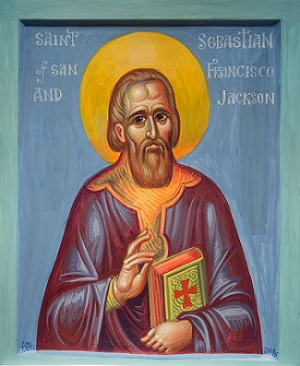 Fr. Stamatis' icon of St. Sebastian
Fr. Stamatis' icon of St. Sebastian What I tried to do what was to present two historical figures—Sts. Sebastian and Mardarije. From his life what I understood of St. Sebastian was that he was indeed an apostle, and a person who also lived many years longer than St. Mardarije. In the icon of St. Mardarije I was forced to express a form of pain or sorrow. I studied carefully the images and photos of St. Mardarije that His Grace Bp. Maxim gave me and I noticed right away that he had the manly and brave look of the Serbian people. As a doctor I also recognized that in his face was the pain of tuberculosis. These were the starting points for the iconography of these two saints.
But the way and means that the Orthodox Church teaches us to make icons leads the iconographer to look into the future. In the one icon we see a calmer, more peaceful person, and in the other we see a more tragic reality. But in both cases we see two people that are loved by God and who are illumined by God’s light. We see this of course in the halo depicting the light of Christ and their faces are shining.
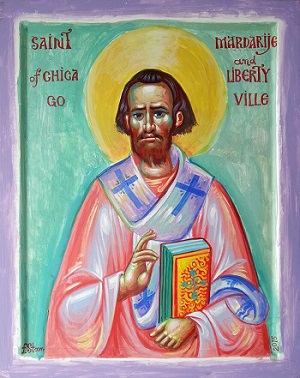 Fr. Stamatis' icon of St. Mardarije
Fr. Stamatis' icon of St. Mardarije In closing let us reflect on the words of St. Maximus the Confessor. He posed the question: “How does God recognize us?” and he answers in saying that He recognizes us by the expression of His will, and so God wills us all personally to be as we are. This is grounded in what Abp. Demetrios said—we must love all people because God wills that each be as we are. If we love God we must love each other as they are, as God wills. This is why we celebrate the uniqueness of the icons of Sts. Sebastian and Mardarije which present their personal qualities. This is why Church art in its many forms must put forward the element of surprise and uniqueness.
Continuing on the theme of the unique personal qualities of St. Sebastian, Fr. Josiah noted that he lived simply in the midst of a burgeoning and virtually lawless city, working for very little and often no salary, and yet he was able to accomplish incredible things for the Church. Quoting His Grace Bp. Irenei of Australia and New Zealand he read:
At the time of his death Fr. Sebastian owned nothing more than a gold cross, some books and a few personal mementos. He had long since given away any significant personal possession to the poor and needy choosing for himself a life of poverty, simplicity, and dedicated missionary service.
To the final speaker, Abp. Benjamin, rector of the Holy Trinity Cathedral in San Francisco (OCA) which served as St. Sebastian’s first parish, Fr. Josiah asked how was it that St. Sebastian was able to maintain his simplicity in such a bustling situation:
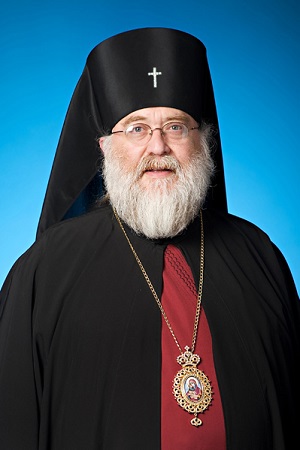 His Grace Archbishop Benjamin
His Grace Archbishop Benjamin Christ is the most humble, and St. Sebastian in imitation of Christ simply focused on his divine calling and I think for him possessions simply got in the way of traveling a lot and bringing the Gospel across the length and breadth of the US. When I have to travel to New York it doesn’t take me a year—it takes five hours. That was not the life of St. Sebastian. He traveled to Alaska—probably one of the most remote places in the world at that time—and served in the cathedral in Sitka. He traveled across the US. He simply had no room in his life for a lot of baggage.
I’ll tell you a story about a funeral. There was a woman I knew when I was a choir director in Detroit, and she had many possessions. She had been a nurse, well paid, never married. Every time she went on a vacation she brought back some kind of expensive souvenir, and if you got an invitation to her house for dinner it meant that you were going to have to endure a tour of her many things. One day we got a phone call that she had died and so I went with the priest to her house, and there she sat in the living room in her bathrobe, dead in a chair, and suddenly all these things that had been so important to her became the junk that her family had to get rid of.
And I would ask all of us to think seriously about our lives. If you’ve been to a funeral—how much of the stuff we collect in our lives goes into the coffin with us? How much can we take into the kingdom of Heaven? If we’re going to invest money in the Bank of America or stock that’s fine, but you can’t take it with you. If you want to invest, invest in the stomachs of the poor. Invest in the bank of the kingdom of Heaven. And I think that’s something that St. Sebastian understood and he took the kingdom of Heaven with him instead of several suitcases. And I think that’s a lesson for all of us. When I die I’m going to leave behind just stuff that somebody else has to dispose of. When St. Sebastian departed for the kingdom of Heaven his bags were full, but full of the spiritual wealth that he gained in his life. He emptied himself, he gave his life for the Orthodox Christian faith just like Christ gave His life for this world. And each of us is called upon in our life to simply imitate that. How do we empty ourselves for our neighbor? How do we show our love for our neighbor? Do we hold onto things or do we open our arms and give them out as Christ gave His life for the world?
His Grace’s words were a fitting end to a symposium which celebrated the life of one who truly opened his arms, giving away all for the love of Christ, His Church, and His people and thus attained to the holiness of Christ.



